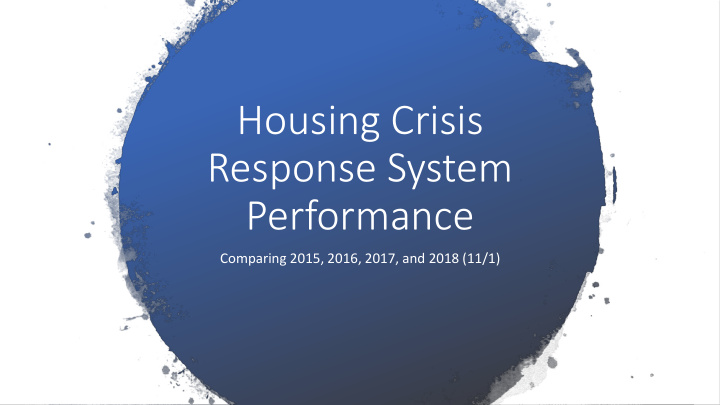



Housing Crisis Response System Performance Comparing 2015, 2016, 2017, and 2018 (11/1)
HUD System Performance Measures • 6 key performance measures that every Continuum of Care reports to HUD annually through the CoC funding competition • Standard Measures: the universe and equations are defined by HUD and provided to HMIS vendors so that CoC performance is comparable • For more information about the measures and their calculation, see System Performance Measures, An Introductory Guide • Presentation excludes a graph of Measure 4, Growth in Income, because the tables are very complex. Also excludes Measure 6, which is now defunct.
Measure 1: Length of Time Homeless • What does it measure? • How effective is our system in ending homelessness? • How does it measure? • Measure 1a: length of time from first ES or TH enrollment to housing move in. • Measure 1b: length of time from self-described start of homelessness to housing move in. • What do we want to see? • Shorter is better • Also desirable: average and median are the same.
Measure 1A: Le Length of f Tim ime Homeless
Measure 2: Extent to which persons who exit to permanent housing return to homelessness • What does it measure? • Whether our interventions are effective and long-lasting in ending homelessness. • How does it measure? • Follows people who exited PH during the fiscal year 2 years previous and counts the number of people re-appear in HMIS in the subsequent two years. • What do we want to see? • Decreasing proportion would indicate that we are effectively ending homelessness.
Mea easure 2: : Ext Extent t to o whi hich pe persons who ho exi xit t to o pe perm rmanent hou housing retur turn to o hom homele lessness
Measure 3: Number of Homeless Persons • What does it measure? • Change in the number of sheltered homeless people in HMIS (annual) • Change in the number of unsheltered homeless people (PIT Count, biennial) • How does it measure? • Provides an unduplicated count of people who stayed in interim housing programs (ES and TH). • What do we want to see? • Overall, we want to see a reduction in the number of people who are homeless. • Right now we may want to see an increase in unduplicated individuals served by shelters as a sign of system flow to permanent housing.
Measure 3: : Undupli licated Count t of f Sh Sheltered Homeless Persons in in HMIS
Measure 4: Employment and Income Growth • What does it measure? • Changes in income for adult system stayers and leavers. • How does it measure? • Compares income and non-cash benefits at program entry, annual update, and exit assessment for adults in TH, RRH, and PSH projects. • What do we want to see? • A growing percentage of adults who gain or increase employment or non- employment cash income.
Measure 5: First Time Homeless • What does it measure? • How many people became homeless for the first time during the reporting period. • How does it measure? • Counts the number of people who entered ES, TH, RRH, and PSH programs during the year and subtracts those with a project entry within the prior 24 months. • What do we want to see? • Decreasing number of people becoming homeless for the first time
Measure 5: : Fir First t Tim Time Homeless
Strategic Update Target: Decrease the Number of People Becoming Homeless for the First Time to Less than 2,500 in FY2019
Measure 7: Exits to/Retention of Permanent Housing • What does it measure? • How many people exited our system to permanent housing, or retained permanent supportive housing. • How does it measure? • Counts the number of people with successful housing outcomes for each grouping of intervention: • Street Outreach: exits to interim and permanent housing destinations • Emergency Shelter, Transitional, and Rapid Re-Housing: Perm housing destinations • Permanent Supportive Housing: retention and exits to other perm housing destinations • What do we want to see? • Increasing the proportion of people who exit to, or retain permanent housing
Measure 7: : Exit xits to Permanent Housing from ES, , TH, , and RRH
Strategic Update Target: Increase the Number of People Ending Homelessness in Permanent Housing to 2,000 or More in FY2019
Recommend
More recommend